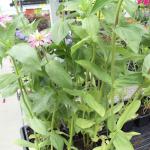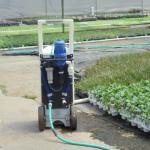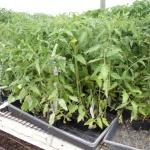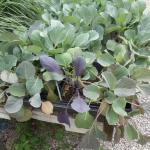When plants are moved to retail areas, the hope is that turnover will be quick and plants will be in the retail space for a short period of time. Due to the current COVID-19 pandemic, plants may remain in retail spaces for longer than expected. To maintain quality of plants and keep them looking their best, it is important to take certain steps:
1. Continue to provide plants with adequate nutrition.
Some of the most common plant nutrient problems in the retail space include:
- Nitrogen (N) deficiency: N deficiency symptoms can appear when plants are not being fertilized. N deficiency shows up as yellowing (chlorosis) of the lower (older) leaves. If a fertilizer injector is not installed in the retail area, use a portable injector. Apply N in the range of 50 to 100 ppm at every watering. Do not apply fertilizer at higher rates in order to avoid fast, excessive growth. Choose a neutral fertilizer with low phosphorus and very low potential pH change such as 17-4-17. High phosphorus will encourage plants to stretch.
- Phosphorus (P) deficiency: Symptoms of phosphorus deficiency are reddening or purpling of older leaves. The top of the plants may appear darker green. Sometimes P deficiency can occur due to slower rates of uptake by plants exposed to cool spring temperatures in outdoor retail areas. Adding P will not help correct the problem, and as noted above can cause plants to stretch. If possible, move plants to a heated space until outdoor temperatures warm up.
- Iron deficiency: Iron deficiency shows up as interveinal chlorosis on the youngest leaves of iron inefficient crops such as petunia and calibrachoa. Iron deficiency can occur in retail areas due to low rate of uptake by plants caused by low substrate temperature and/or saturated (overwatered) substrate. Iron deficiency may also occur due to high growing media pH. This can be corrected by adjusting media pH by adding acid fertilizer. A foliar application of a chelated iron can remedy iron deficiency symptoms but does not fix the problem. It helps green up the plants quickly in order to sell them. Once the plants are planted in the landscape, there is typically adequate amounts of iron available in the soil.
2. Water properly.
If plants are not watered properly, they can show signs of nutrient deficiency, or be more prone to root diseases that mimic nutrient deficiency. Inadequate watering is a common problem in the retail area. Keep plants adequately hydrated but do not overwater. To avoid overwatering, keep plants on the drier side without allowing them to wilt. Inspect plants regularly and water only as needed, instead of following a set schedule. Watch the weather forecast. If rainy weather is expected, reduce watering to avoid overwatering.
3. Space plants adequately.
Plants grown with adequate spacing tend to be more compact and uniform. If plants are tightly packed in the display area they can stretch and become leggy due to shading from other plants. Be sure to give plants adequate space. Spacing plants well also helps to improve air movement between plants which helps prevent spread of foliar diseases.
4. Monitor plants regularly for pests.
Train employees to inspect plants regularly for insect pests, mites, and diseases while watering and grooming plants. Inspect all incoming plants before placing them in the retail area. Remove plant debris and weeds regularly and place them in a covered garbage container or compost pile located well away from the retail space (as long as they are free from disease)
For more information on caring for plants in retail settings:
https://ag.umass.edu/greenhouse-floriculture/fact-sheets/caring-for-plants-in-retail-setting
Geoffrey Njue, Extension Educator, UMass Extension Greenhouse Crops and Floriculture Program




